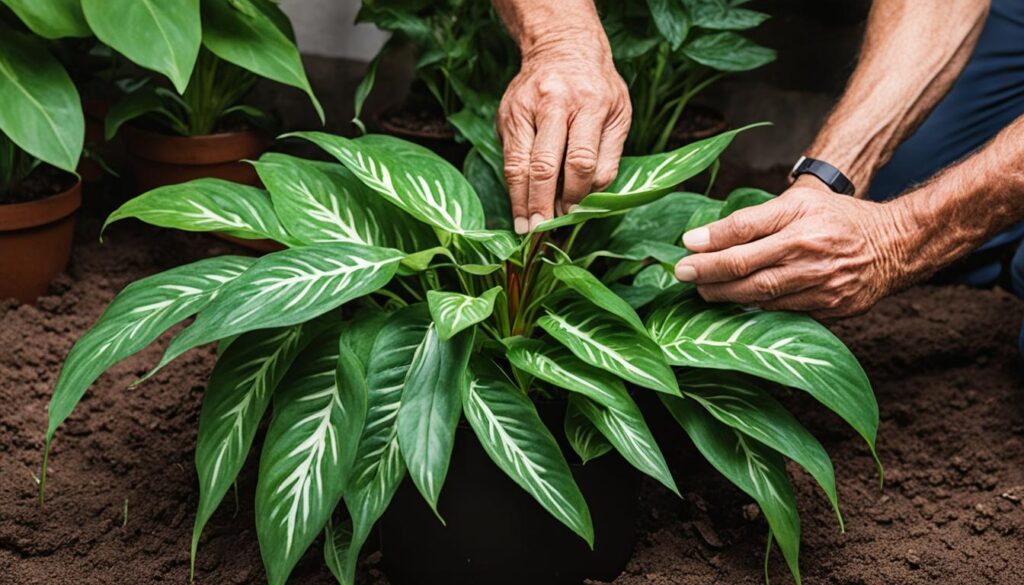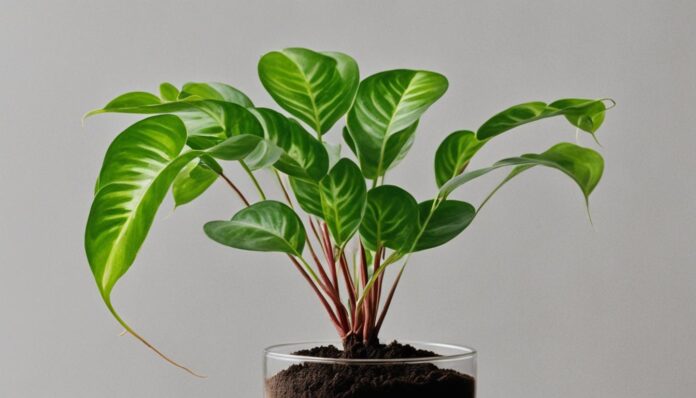Maranta leuconeura, commonly known as prayer plants, are beloved for their striking striped leaves and are relatively simple to propagate. The most successful method for propagating prayer plants is through division. By following these five straightforward steps, you can effectively propagate your prayer plant:
- Gently remove the mother plant from its pot and shake off any excess soil from the roots.
- Identify clusters of stems with their own root systems and carefully separate the plant at the roots, ensuring that each division has healthy stems.
- Repot each division in a new pot with fresh potting mix.
- Water the newly potted divisions and place them in a warm location with indirect sunlight.
- Care for your new prayer plant divisions by providing good light (but not direct sunlight), keeping the soil damp (but not soggy), misting the leaves regularly, and liquid-feeding weekly during the growing season.
Key Takeaways:
- Prayer plants can be successfully propagated through division.
- Gently separate the plant at the roots, ensuring each division has healthy stems.
- Repot the divisions in fresh potting mix and provide them with adequate light, water, and care.
- Avoid overwatering, excessive sunlight, neglecting leaf misting, using incorrect potting mix, and not providing the right temperature and light conditions for newly propagated prayer plants.
- Once you’ve mastered propagating prayer plants, you can try propagating other popular houseplants like monstera and fiddle leaf fig.
When to Propagate a Prayer Plant
Prayer plants, like many other houseplants, should be divided during the spring, at the start of their growing season. This is the ideal time to propagate prayer plants through division.
Propagating prayer plants in the spring allows them to establish themselves in their new pots and grow successfully.
The spring season provides the perfect conditions for the newly propagated divisions to take root and thrive. As the days become longer and temperatures rise, prayer plants enter their active growth phase, making it easier for them to adapt to their new environment.
“Propagating prayer plants during the ideal season increases the chances of successful growth and survival.” – Gardening Expert
By propagating prayer plants in the spring, you allow them ample time to establish a strong root system before the heat of summer arrives. This gives them a better chance of withstanding any potential stressors and ensures their healthy development.
Benefits of propagating prayer plants in spring:
- Optimal growing conditions
- Faster root development
- Increase in foliage growth
- Higher chance of successful propagation
While it is possible to propagate prayer plants at other times, doing so in the spring provides the best chance for success. By choosing the right season, you set your newly propagated prayer plants up for a healthy and vibrant future.
Propagating Prayer Plants by Taking Cuttings

While dividing prayer plants is the preferred method of propagation, it is also possible to propagate them by taking cuttings. Although slightly trickier, this method can be successful with proper care and attention. Here’s how you can propagate prayer plants using cuttings:
- Start by using sharp and clean pruners to remove a healthy stem from the plant. Make the cut just below a leaf node, ensuring that the cutting is around 4-6 inches long.
- Prepare a pot with well-draining potting soil. Insert the cutting into the soil, burying it about an inch deep. Gently firm the soil around the cutting to ensure stability.
- Cover the pot with a transparent plastic bag to create a mini greenhouse effect. This helps to increase humidity and create an ideal environment for rooting.
- Place the pot in a location that receives bright, indirect light. Avoid direct sunlight, as it can cause damage to the cutting.
- Keep the soil consistently moist, but not waterlogged. Monitor the moisture levels regularly and adjust watering accordingly.
- If you prefer to propagate the cutting in water, submerge the bottom inch of the cutting in a container of water. Change the water every few days to prevent stagnation.
- After a couple of weeks, the cutting should start developing roots. You can gently tug on the cutting to check for resistance, which indicates root growth. Once roots have formed, remove the plastic bag or transfer the rooted cutting to a fresh pot with potting soil.
With proper care and attention, your propagated prayer plant cutting will develop into a thriving plant. Remember to provide it with the necessary light, water, and humidity requirements to promote healthy growth.
Common Mistakes to Avoid in Prayer Plant Propagation
When propagating a prayer plant, it’s important to be aware of common mistakes that can hinder the success of propagation. By avoiding these errors, you can increase the chances of successfully propagating your prayer plant. Take note of the following common mistakes to avoid:
- Overwatering the newly potted divisions: One of the most common mistakes in propagating a prayer plant is overwatering the newly potted divisions. Excess moisture can lead to root rot and plant damage. It’s crucial to provide the right amount of water, ensuring the soil is moist but not waterlogged.
- Allowing too much direct sunlight: Another mistake to avoid is exposing the divisions to excessive direct sunlight. Prayer plants prefer indirect light, and too much sunlight can cause leaf scorching. Find a spot that provides bright, indirect light for your newly propagated prayer plants.
- Neglecting to mist the leaves regularly: Prayer plants thrive in a humid environment similar to their tropical habitat. To simulate this, regularly mist the leaves of your prayer plants. Neglecting this important step can result in dry and unhealthy foliage.
- Using incorrect potting mix: Using the wrong potting mix or failing to repot the divisions in fresh potting mix can negatively impact their growth. Make sure to use a well-draining potting mix suitable for prayer plants to provide optimal conditions for your propagated plants.
- Failing to provide the right temperature and light conditions: The success of prayer plant propagation also depends on the right temperature and light conditions. Avoid subjecting the divisions to extreme temperature variations or placing them in areas with inadequate light. Maintain moderate temperatures and provide the appropriate amount of light for healthy plant growth.
To ensure successful prayer plant propagation, steer clear of these common mistakes and provide the proper care and conditions for your newly propagated plants. By avoiding these errors, you’ll increase the likelihood of thriving and beautiful prayer plants in your home.
Other Houseplants to Propagate
After successfully propagating your prayer plants, you may be interested in expanding your plant propagation skills to other popular houseplants. Two houseplants that are commonly propagated are the Monstera and the Fiddle Leaf Fig.
Monstera, also known as the Swiss cheese plant, can be propagated through division or by taking cuttings. Division involves separating a mature plant into smaller sections, each with its own root system. Cuttings can be taken from the stems and roots can develop when placed in water or potting soil. Propagating Monstera allows you to grow new plants and expand your collection.
The Fiddle Leaf Fig is another houseplant that is commonly propagated. This trendy plant can be propagated through stem cuttings. Take a healthy stem cutting from the plant, ensuring it has at least one leaf node. Place the cutting in water or potting soil, providing it with the right conditions to develop roots. Soon, you’ll have a new Fiddle Leaf Fig plant to add to your indoor jungle.
Propagating houseplants like Monstera and Fiddle Leaf Fig not only allows you to increase your plant collection but can also be a rewarding and fulfilling hobby. Remember to research the specific propagation methods for each plant to ensure success. With time, patience, and proper care, you’ll be able to enjoy the satisfaction of growing new plants from existing ones.
FAQ
How do you propagate a prayer plant?
The preferred method for propagating a prayer plant is through division. Gently remove the mother plant from its pot, separate the plant at the roots, and repot each division in fresh potting mix.
When is the best time to propagate a prayer plant?
Prayer plants should be divided during the spring, at the start of their growing season. This allows them to establish themselves in their new pots and grow successfully.
How do you propagate a prayer plant by taking cuttings?
To propagate a prayer plant with cuttings, remove a healthy stem from the plant and plant it in potting soil. Keep the soil moist and provide bright, indirect light until the cutting develops roots.
What are some common mistakes to avoid in prayer plant propagation?
Some common mistakes to avoid include overwatering the divisions, exposing them to too much direct sunlight, neglecting to mist the leaves regularly, using incorrect potting mix, and failing to provide the right temperature and light conditions.
Can other houseplants also be propagated?
Yes, popular houseplants like monstera and fiddle leaf fig can also be propagated using similar methods, such as division or taking cuttings.
Discover More Gardening Secrets: Ready to explore further? See how to utilize small spaces with “Vertical Gardening: New York Urban Oasis Secrets“, delve into “Creating Outdoor Living Space: Transform Your Backyard into an Oasis“, learn about unique plants in “Persian Lily Fritillaria: A Unique and Exotic Garden Addition“, and understand plant care with “How to Propagate Anthurium: A Comprehensive Guide“.

